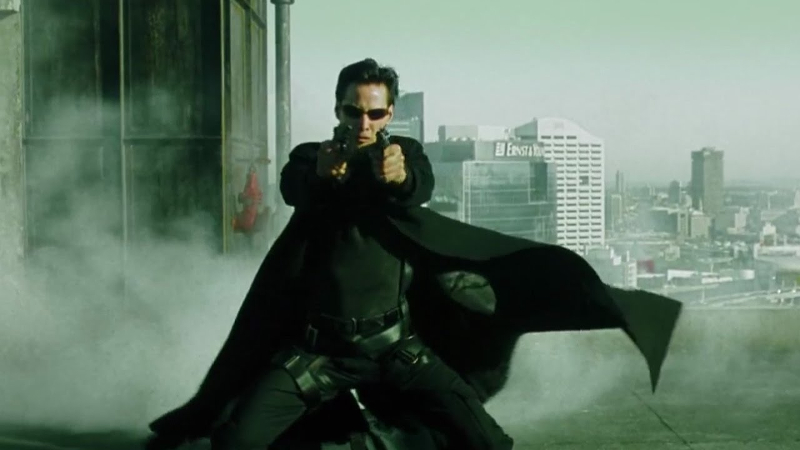Directors – Larry and Andy Wachowski – 1999 – US – Cert.15 – 136 mins
*****
The Matrix combines tropes of Japanese animation with live action Hong Kong stunt choreography and groundbreaking ‘bullet time’ special effects.
25th Anniversary UK rerelease (4k remaster): Friday, June 8th, 2024;
UK release: June 11th 1999;
Article originally published in Manga Max, Number 8, July 1999.
—
1999. The Matrix is about to E.X.P.L.O.D.E.
Technically, a matrix is a multidimensional array of locations, with each cell uniquely addressable. Contents not specified. Back in late April, when Hollywood blockbuster The Matrix was first screened for UK press, Warners’ line beneath the film’s title on the publicity flier ran, Blockbusting futuristic thriller with ground-breaking special effects. Perhaps it should have read, Blockbusting futuristic thriller with ground-breaking special effects and Hong Kong styled action. Or even, Blockbusting futuristic thriller with ground-breaking special effects and Hong Kong styled action reconceived in terms of anime. Okay, it’s a bit of a mouthful, but it’s closer to the truth.
Ostensibly a megabudget Joel Silver (Lethal Weapon / Die Hard / Predator / Speed / Road House / Assassins) SF actioner well beyond the extremities of this magazine’s remit, directed by the Wachowski Brothers (writer‑directors of Bound, screenwriters for Assassins), The Matrix opens with an incredible sequence wherein Trinity (Carrie‑Anne Moss, who looks for all the world like a Westernised version of a Hong Kong starlet in cat burglar get up… Black Cat’s Jade Leung or Irma Vep’s Maggie Cheung, perhaps?) is found by a group of Men In Black led by Aussie actor Hugo Weaving playing a character named Agent Smith whom one might tenuously link to Akira‘s heavily shouldered Colonel. Messianic undertones can be likened to those of the original Star Wars (itself a remake, remodel of, among other sources, Akira Kurosawa‘s Hidden Fortress) as Neo (Keanu Reeves) wonders whether he is – as Morpheus (Laurence Fishburne) believes – The One who will save the world from The Matrix.
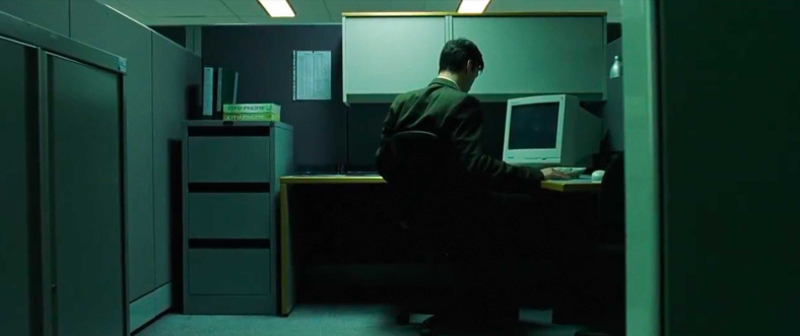
Little Neo In Slumberland
Representing a monumental leap forward for the Wachowskis, The Matrix goes one better than Bound‘s film noir mise-en-scene via a style one might reasonably describe as film vert (that’s green, for non‑speakers of French), lending the feel of Ghost In The Shell shot in live action with a bottle-green filter permanently stuck over the lens. Opening, number-crunching titles suggest alternately Ghost In The Shell or more recent cult American indie favourite Pi, while the plot’s subsequent development of Weaving’s law enforcement officer points to the conflict between human and machine sensibilities explored in Blade Runner, The Terminator, Shinya Tsukamoto‘s Tetsuo films and the Kusanagi character in Ghost. The name Morpheus even betrays a throwback to ‘father of animation’ Winsor McCay‘s seminal, turn of the century New York Herald strip Little Nemo In Slumberland, filmed by the French in live action and the Japanese in animation. “Our image-based approach to film making reflects the medium’s graphic nature – it’s about pictures,” say Larry and Andy Wachowski.
Let’s return to Trinity’s incredible, introductory short skirmish with and subsequent flight from her pursuers which looks – as she kickboxes, runs and leaps impossibly over massive gaps between rooftops – totally unlike the leaden action choreography found in most American movies and considerably closer to the high octane stunts of Hong Kong action cinema. This resonates with the movie’s very core. “Once you start dealing with a digital reality you can really push the boundaries of what might be humanly possible,” state the Wachowskis. “So, if characters in The Matrix can have information instantaneously downloaded into their heads, they should, for example, be able to be as good a Kung Fu master as Jackie Chan.”
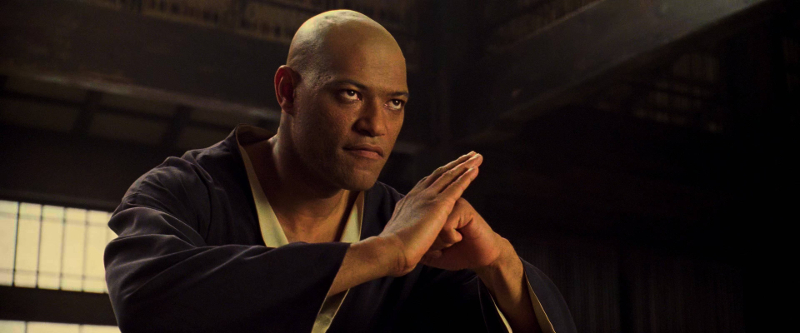
With the full support of producer Silver, the brothers took the bold and unprecedented move of hiring Hong Kong legend Yuen Wo Ping, director of such celebrated fare as Iron Monkey and Tai Chi Master not to mention stunt director of Jet Li vehicles Last Hero In China, Fist Of Legend and Black Mask. Yuen trained the cast in basic physical martial arts movie techniques and The Way Of The Wire for some four months – three in L.A. followed by one in Sydney where much of the film was shot (and where, incidentally, Jackie Chan is a naturalised citizen).
“We’re the first Western actors to work in this particular style” claims Fishburne of the Asian cinematic wire techniques employed (ably demonstrated in Jackie Chan – My Stunts – see review pages). He exaggerates, presumably due to unfamiliarity with the Hong Kong-trained likes of Gary Daniels (interviewed back in the now sold out MM 40, which must surely be due for a reprint), Richard Norton, Cynthia Rothrock and the higher profile Jean-Claude Van Damme. An additional Hollywood precedent comes in the form of Dutch-born director Paul Verhoeven, who memorably pit kickboxing then bit player Sharon Stone against Rachel Ticotin in Total Recall much as he later did infantry recruit Dina Meyer against grizzled training sergeant Clancy Brown in Starship Troopers.
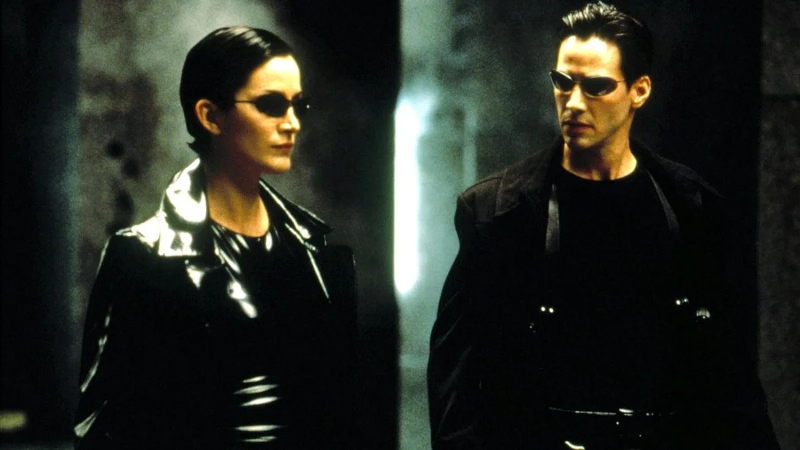
But in The Matrix, sequence after sequence appears grounded in Hong Kong action sensibilities to an unprecedented degree for a megabudget US Studio movie. One extraordinary, rope-ladder dangling actors helicopter pursuit recalls nothing so much as Jackie Chan’s death defying ride above the streets of Malaysian capital Kuala Lumpur in Police Story III: Supercop (covered extensively in MMx 3’s Police Stories feature) except that, where Chan did it for real, The Matrix‘s audience knows (even if they can’t see the onscreen join) that the stunt has somehow been composited in the computer and the stars are not in the same danger of falling to their deaths as Chan. But since The Matrix concerns electronically generated environments, subliminal awareness of computer compositing serves merely to enhance the subject matter.
Curiously, the one Hollywood precedent is the similar helicopter / rope-ladder sequence that closes Darkman, conceived and directed by self-confessed Hong Kong action fan and sometime exec producer of John Woo‘s American debut Hard Target Sam Raimi. Which brings us rather neatly to The Matrix‘s exec producer Barrie Osborne, who previously worked in similar capacity on Woo’s Face/Off and whose prior credits are illuminating given The Matrix‘s subject matter: Bride Of Chucky with Hong Kong helmer Ronnie Yu, megabudget American comic book underworld outing Dick Tracy and last, but by no means least, China Moon, a terrific Florida Noir directed by esteemed cinematographer John Bailey. Although the Wachowskis wanted to hire the stunt choreographer of Fist Of Legend, it was Osborne who was able, via his own Hong Kong contacts including Shaw Brothers, to track down and secure Yuen’s services.
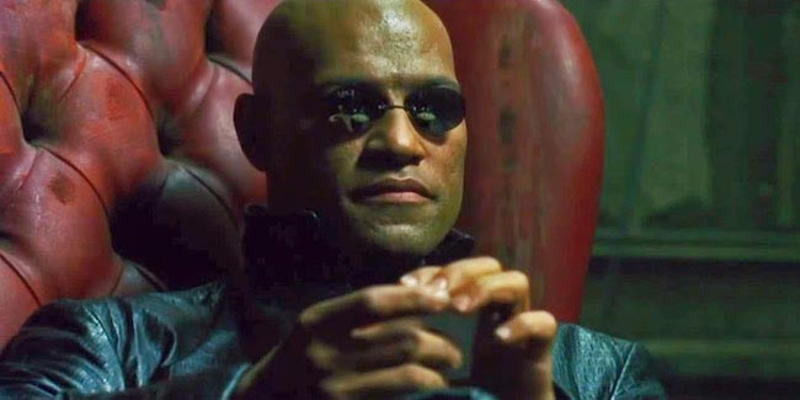
Hong Kong isn’t the Wachowski’s only Oriental influence, given The Matrix‘s use of what they dub the Flow-Mo process of Bullet Time Photography. “The Wachowski’s are from comic book culture, and are therefore familiar with Japanese animation and its accompanying visual style which we recreated for live actors with this movie,” explains John Gaeta, Visual Effects Director of Northern Californian effects outfit Manex. “Anime takes advantage of the Physics of Decimation – it breaks down action into its components and allows these elements to be meticulously controlled to build the most dramatic effect from dynamic movement.”
Any otaku worth his/her salt need only think of all those fighting anime where a combatant leaps into the air, is held as a flat piece of static artwork moving in a given direction across static background art (sometimes just a plain backdrop) to recognise the stylistic phenomenon Gaeta describes. Or, as Joel Silver has it according to the press handouts, “full-cel animation, only with people” – a somewhat confusing description given that “full” generally implies the lavish, labour-intensive pencil animation of Disney‘s Snow White rather than anime with its numerous static pans, successive perpendicular camera angles and frozen holds during fight scenes – which latter element, The Matrix‘s mid-air leap freezes of its Yuen-trained stars so clearly seek to emulate.

The frozen leaps – a similar effect to that of the floating objects in the recent Gap commercials – were accomplished by scanning previously shot footage of a scene into a computer, mapping out the final scene’s intended camera movements by means of a laser-guided tracking system, placing numerous stills cameras along the mapped path and scanning the resultant stills into a computer which treated them as if they were single frames (think of these as being live action or animated – it’s all the same principal) and added in-betweens just as (traditional hand-drawn) animators do. “We’ve gone beyond Ghost In the Shell or Akira by depicting a real life version to the anime style,” says a characteristically hyperbolic Joel Silver.
“I see The Matrix as a groundbreaking movie,” he continues. “The style and the visual effects within the action sequences are something that has never been seen before, plus we have fighting styles and photographic techniques used in this movie that weren’t possible even six months before. We also have some of the most impressive stunt work I’ve ever seen.” You’d be forgiven for assuming that Silver had seen few Hong Kong actioners, but it was however he who gave Jet Li his first US co-starring role in the fourth outing of his own Lethal Weapon franchise. Or moreover, that Silver had forgotten Warner Bros’ own pedigree in the Hong Kong action stakes, being the Hollywood Studio who put together Bruce Lee‘s first Hollywood vehicle Enter The Dragon. Both The Matrix and LW4 show Silver to be exactly the type of producer to benefit from incorporating Hong Kong stunt and effects expertise into his movies. But The Matrix goes further since, as the teaser tagline suggests, the mystery that is The Matrix itself is as much an enigma as the meaning of the word Akira in Otomo’s enigmatic anime feature of the same name.
My thanks to Martin Andrews, Jerry Cheung, Jane Holtom and the wonderfully concise John A.W. “Jaws” Smith for their invaluable technical comments on the nature of a Matrix and Matrices.
Article originally published in Manga Max, Number 8, July 1999.
25th Anniversary UK rerelease (4k remaster): Friday, June 8th, 2024;
Original UK release: Friday, June 11th, 1999.
25th Anniversary trailer:
Original trailer:
